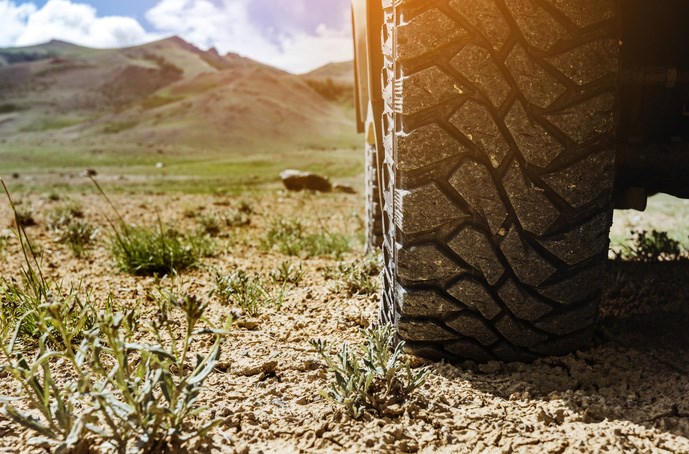In the unfortunate event you get your rig caught in a tough spot, these tips and tricks will get your RV unstuck in no time.
If you feel like you’ve been stuck in a rut lately, a relaxing camping vacation may be just what the doctor ordered. Nothing cures a case of the blahs like loading up the RV or camper and hitting the open road to be one with nature. But nothing upends that relaxation like getting stuck in an actual rut … or the snow, or sand, or mud. Getting lodged in a sticky situation can happen to the most experienced travelers enjoying the great outdoors, but with the right strategies, you can quickly get unstuck and back on your way.
Get the Lay of the Land
There’s an important first step in avoiding sticky situations: Know before you go. That is, don’t take your RV down an unfamiliar dirt or gravel road without first getting the lay of the land. This may even mean walking the route ahead of your vehicle, since it’s tough to tell how firm the path is from the comfort of the driver’s seat. If the ground is soft and slippery underfoot, imagine what will happen when you try a heavy RV on it.
Also, ask around for advice: Other campers can provide information about which local routes are suitable for RVs and which aren’t.
Relieve the Pressure
Consider a situation where you’ve parked your RV on the beach to watch the sunset. It can be the ideal end of the day, unless you get stuck on the loose sand. In those conditions, a simple trick to try is to let some of the air out of your tires, which allows them to get more traction—often enough to get you unstuck. (You’ll need to be ready with a portable air compressor to refill the tires and get back on the move.)
Remember, too, that you shouldn’t deflate your tires so much that you’re riding on the rims, as that can damage the wheels.
Gain Traction
Deflating your tires doesn’t work in the mud or the snow: You’ll still be spinning your wheels and digging yourself in deeper. Tools to increase the traction of your tires are necessary here, such as tire chains or emergency traction mats. Relatively inexpensive, traction mats are usually made from a durable plastic and are specifically designed to offer extra grip under a vehicle’s tires.
Many RV drivers bring carpeting, long planks or plywood scraps to put under the wheels instead. (In fact, some folks park on 2×6 planks if they’re worried about their RV settling into soft ground overnight.) A shovel or axe can come in handy as well, or you can use rocks or dry branches under the wheels. Whatever you use, put it beneath the leading edge of the tires. Then also make sure no one is standing too close when you try the gas.
As an additional tip, you can use your RV’s jack to carefully lift the wheels enough to get more traction material beneath them. This is particularly helpful if your vehicle is hung up on rocks or other obstacles, with the tires not touching the ground.
Rock and Roll
The very first thing you should do if you suddenly find yourself in a slippery spot is simply to keep going straight and steady, without goosing the accelerator or hitting the brakes. Maintaining your forward momentum is the key. If you do get stuck going forward, try backing out the way you came, very gradually pressing on the accelerator in reverse.
If that doesn’t work, you’ll want to go back and forth between reverse and the lowest forward gear, using gentle pressure on the gas pedal, and waiting for the wheels to stop moving before you shift your transmission. If you happen to be in a four-wheel-drive vehicle, instead of a rear-wheel-drive RV, you can try turning the front wheels back and forth at the same time. This allows the sides of the front tires to get a little extra traction in some cases.
Use Some Tools
What if you need more than your RV’s own power to get unstuck? Having tools can make a difference. With a winch, for example, you may be able to pull yourself free from the mud or muck, and if you have recovery straps, a friendly motorist may be able to help haul you out. Having your own winch or straps also has another vital advantage: Provided you’ve done your homework, you can be sure those items have the right load capacity to get the job done. Indeed, being prepared also means knowing the correct attachment points. (That doesn’t make it less potentially dangerous, though, and people should always stay well back in case a cable or strap does break.)
Finally, no matter how self-reliant you want to be on your camping trip, there may come a time when you need to call in professional help to get on your way. With that in mind, a last must-have item to help the modern-day camper get unstuck is something none of us should travel without: a fully-charged cell phone. Knowing these tips will help you maneuver difficult driving situations and hopefully prevent damage, which will also preserve the overall value of your vehicle.
A Detroit native, Charles Krome has been a car enthusiast since childhood. He now writes for CARFAX about all things related to car buying and ownership. He enjoys sharing tips on how to buy the right vehicle for your lifestyle including camping and outdoor adventures.

























